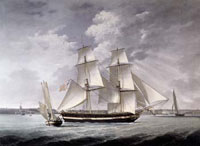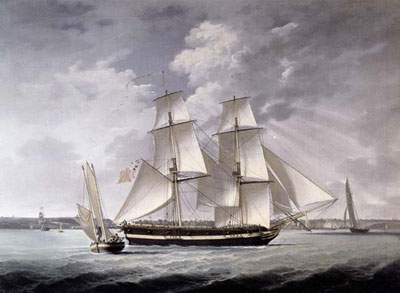
Kwame - On the ship
The worst time of my life was in the despair of that stinking, black, silent hole with hundreds of men and boys. Then a white man picked me. Kessie, my wife, used to say I have a proud face - I think it has helped me here. This man looks different to the others - cleaner and with different, finer clothes. He seems to be a kind of doctor but I don't recognise his methods or tools. I am careful not to anger him.
Armed Vessel

'Armed vessel in the Mersey off Birkenhead' by John Jenkinson painted 1800-21. This unidentified ship is typical of the large merchant ships involved in slaving from Liverpool. She may have been purposely built as a slaver.
Hole
This hole is the hold; the space in a ship where cargo is usually kept. Hundreds of Africans were crammed into these hot, humid spaces without water, fresh air or space. They often had to sit or lie in each other's vomit, blood and excrement. Disease spread quickly.
Men and Boys
Ships in 1780 carried around 330 slaves although some carried many more. Men and women were separated. It was said that this was to stop male captives seducing female captives, and also to prevent women encouraging the men to attack the crew.
Doctor
Some European governments tried to improve conditions on board ship (mainly for the benefit of the crew). They reduced the number of people allowed on board and ordered that each ship carry a surgeon. These, often unqualified men, helped the captain select the healthiest Africans for purchase, and on board were paid to keep the captives alive.
The law to reduce the number of people allowed on board was introduced in 1788 by Sir William Dolben, MP for Oxford University. He was moved to act following a visit to an empty slaving ship in the Thames, where he was horrified by the chains and cramped conditions he saw.
Him
The surgeon, as part of his payment for the journey, has selected Kwame.


